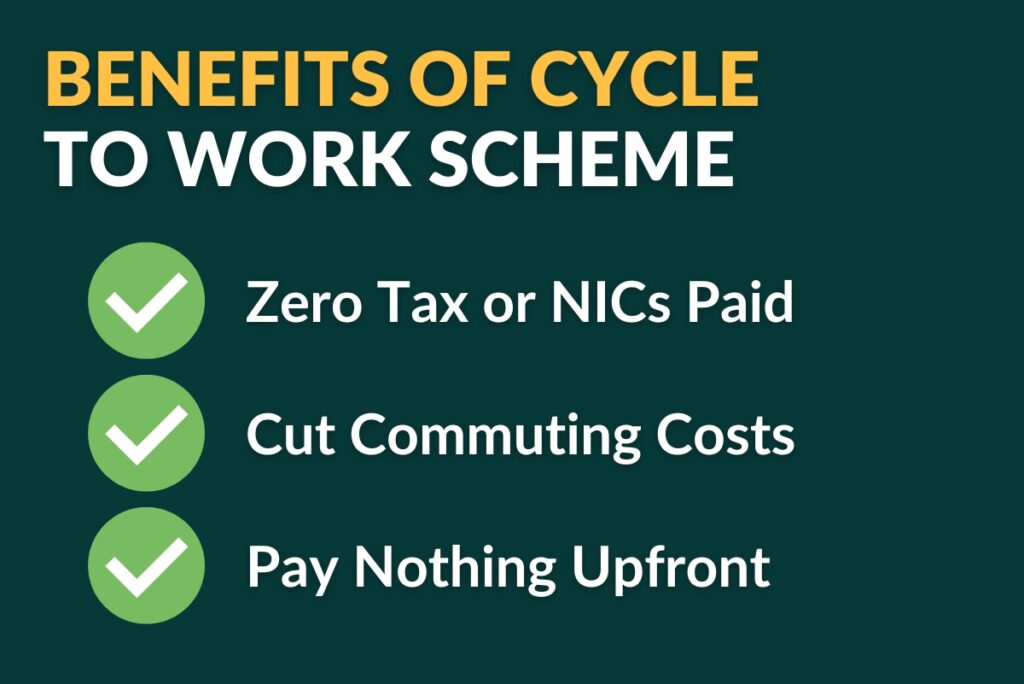
Employees check the availability of bicycles and essential qualifying accessories such as locks, helmets, lights and waterproof clothing. A qualifying condition is that the bicycle is used more than 50% of the time for commuting. Electric bikes are included. There is no limit on the value of the package applied for, subject to salary and employer’s choice of scheme.
The items should be quickly acquired. With no upfront costs, payment for the package is spread over a number of months but the employee is up and running quickly. When one scheme hire agreement finishes, the employee can reapply for a new one.

| PROS | CONS |
|---|---|
| Spreads the cost of starting cycling from scratch | You don’t own the bicycle or accessories at first |
| Wide range of shops accept eCertificate redemption code | Employers can limit credit to £1,000 to save on administration |
| Employers can promote lifestyle benefits with more credibility | You pay for maintenance / repair for a bicycle you are essentially hiring |
Employers must commit to any Cycle to Work scheme. They have to pay for employees’ bicycles up front. It increases the work of HR departments. It requires PAYE and payroll to work with it. Facilities may need to be upgraded to accept showering, changing and secure areas to store the bicycles.
Some employers will limit the amount an employee can apply for. Any request above £1,000 influences whether the employer requires authorisation from the Financial Conduct Authority. Some circumstances mean the employer should be considered a Credit Broker. Employers may simply choose to avoid the cost and hassle associated with this extra administration.
There is technically no limit on how much you can spend on the Cycle to Work scheme. However, this is down to your own employer. They are under no obligation to offer an excess of more than £1,000, although employers will typically offer more if administration is not an issue.
This depends upon your investment in cycling. If you are starting out, looking for a commuting option without significant upfront cost, comfortable with hire agreements and the end of hire options, it could work. Taking it up implies you are comfortable with taking tax out of the economic cycle.
You will be making positive contributions to your health and of those around you by participating in an energetic, low-emission activity. You will be reducing the cost, no doubt, of your commute to work.
You’ll save money in the long-run on the acquisition of a bicycle and accessories. If you choose to buy at the end of the agreement, your outlay will be the total cost of the salary sacrifice plus the agreed value of the bicycle at the end of the hire agreement. Plus an ownership fee.
50,000 employers have signed up to Cyclescheme as of August 2021, according to its website. Multinational companies appear as members.. They have economies of scale and sophistication within their payroll departments to manage Cyclescheme. The corporate responsibility of empowering a healthier workforce and lowering emissions will feature in their annual planning and their facilities departments can cope with infrastructure changes.
However, for SME businesses, attracting the right calibre of employee could still depend on just this type of employee benefit, despite the fixed costs and payroll issues.
Even if you only plan to commute, then you need to factor in that repairs and maintenance are all more or less necessary facts of life. You should decide quickly how much you are willing to part with in order to service and maintain a bicycle if you intend to give it back at the end of the hire agreement.
You also need to consider the cost of replacement components if you have an accident that requires them to be replaced or upgraded if no longer stocked. You should then consider if and when you will ride in colder, darker, wetter months. In both instances, if you aren’t riding, you’ll still be sacrificing your salary for the duration of the hire agreement and may have to pay for your commute too.
If you move away from your employer before the end of the hire agreement, it is likely that your employer will deduct the outstanding balance of the hire agreement from your final salary. Or ask you to settle the balance where it exceeds the final salary.
To get a bike on the scheme, your employer needs to sign up. To start your application, you need to submit the code of your employer, your payroll number and your bicycle budget (i.e. how much you want to spend).
Once set up, you can begin your process of finding qualifying bicycles and accessories. Some members of Cyclescheme will offer sale or discounted stock as qualifying equipment, so consider the appropriate time of year to apply.
As an employer, setting up will depend on your size, flexibility, business objectives and willingness to invest. Cyclescheme provides helpful guides and FAQs in order to get you started and field any concerns.
SEE MORE: